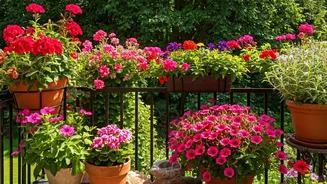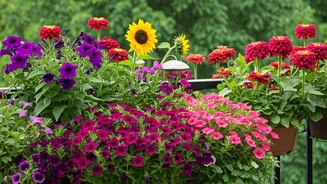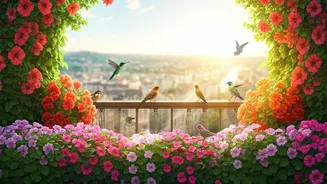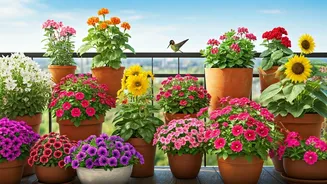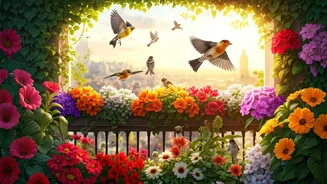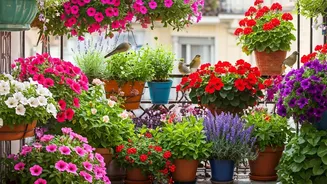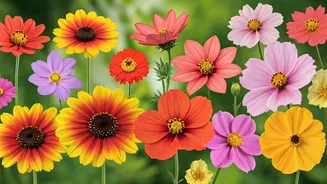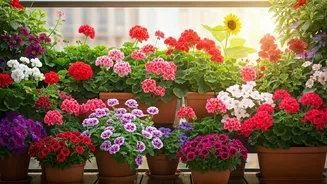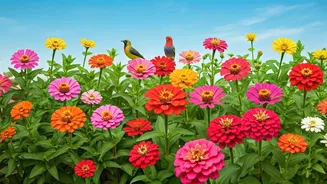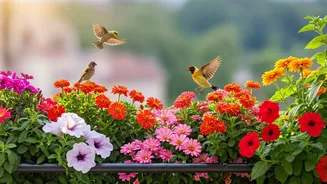Creating Bird Paradise
Creating a bird-friendly balcony garden involves more than simply planting flowers. The overall design should consider the needs of birds, like providing
shelter, water, and a variety of food sources. Incorporating plants that offer different blooming seasons ensures a consistent supply of nectar and seeds throughout the year. Consider including shrubs or small trees that provide cover from predators and the elements. A small bird bath or water feature is crucial for drinking and bathing. Avoid using pesticides, as these can be harmful to birds. Also, be mindful of cats, which can be a threat. Creating a safe and welcoming environment will attract a diverse range of bird species. The strategic selection of plants and careful consideration of the overall design can make your balcony a thriving bird habitat.
Marigolds: Sunny Charms
Marigolds are sunny, easy-to-grow annuals that are a magnet for various birds. Their bright orange and yellow blooms not only add a splash of color to your balcony but also attract birds seeking nectar and seeds. Marigolds are relatively low-maintenance, thriving in full sun and well-drained soil. They can be grown in pots or containers, making them perfect for balcony gardens of any size. Regularly deadheading (removing faded flowers) encourages more blooms, extending the season of attractiveness for birds. Different species of marigolds come in various sizes and forms, allowing you to choose varieties that fit your specific balcony setup. The simple act of planting these cheerful flowers can create a lively and inviting space for birds to visit and forage.
Petunias: Vibrant Displays
Petunias provide a vibrant display with their trumpet-shaped flowers in a wide array of colors. These flowers are not only visually appealing but also a source of nectar that attracts hummingbirds and other small birds. Petunias prefer full sun and regular watering, and they can be grown in hanging baskets, pots, or window boxes. To ensure a continuous bloom, it is essential to deadhead the spent flowers regularly. Petunias come in various forms, including trailing and upright varieties, allowing you to create different visual effects on your balcony. Their ability to thrive in containers makes them a versatile choice for any balcony garden. The cheerful blooms of petunias make your balcony attractive to birds and enhance its beauty.
Zinnias: Colorful Choices
Zinnias are another excellent choice for attracting birds to your balcony. These vibrant, daisy-like flowers come in various colors and provide a valuable food source for birds, especially as they begin to produce seeds. Zinnias thrive in full sun and well-drained soil. Regular deadheading helps to promote more blooms and ensures a continuous supply of food for birds. Zinnias are relatively low-maintenance and can be grown easily in pots and containers. The different sizes and forms of zinnias allow for varied arrangements in your balcony garden. Their bright colors and easy care make zinnias a delightful addition that attracts birds throughout the season.
Sunflowers: Grand Attractions
Sunflowers, with their towering heights and bright yellow faces, are a grand attraction for birds. These plants not only provide nectar but are also a significant source of seeds, which many birds love to eat. While full-sized sunflowers might be challenging for a balcony, dwarf varieties can be a great alternative. They still offer the same benefits on a smaller scale. Sunflowers need full sun and well-drained soil to thrive. Once the flowers have faded, allow the seed heads to dry and mature, providing a feast for birds. These tall blooms create a focal point, drawing birds to your balcony and offering a striking visual contrast with their vibrant colors. Dwarf sunflowers are perfect for creating a bird-friendly haven on a balcony.
Lantana: Butterfly Magnet
Lantana is a versatile plant that attracts both birds and butterflies. Its clusters of colorful flowers are rich in nectar, making it a favorite among hummingbirds and other small birds. Lantana prefers full sun and well-drained soil and is relatively drought-tolerant once established. It can be grown in pots or hanging baskets, making it suitable for any balcony garden. Regular pruning can keep the plant in shape and encourage more blooms. Lantana's ability to attract both birds and butterflies increases the biodiversity of your balcony garden. With its vibrant colors and easy care, lantana is an excellent addition to any bird-attracting balcony.
Nasturtiums: Edible Bounty
Nasturtiums offer a unique combination of beauty and functionality. Their vibrant, edible flowers and leaves provide nectar for birds and can be used in salads or as garnishes. Nasturtiums are easy to grow, preferring full sun or partial shade and well-drained soil. They can be grown in pots, hanging baskets, or window boxes, adding a touch of color and flavor to your balcony. Their trailing growth habit makes them ideal for hanging arrangements. The edible nature of nasturtiums makes them a practical choice. The variety of colors and ease of care make nasturtiums a delightful addition to attract birds.
Salvia: Hummingbird Favorite
Salvia, with its vibrant spikes of flowers, is a favorite among hummingbirds. The tubular shape of the flowers is perfectly designed for hummingbirds to reach the nectar inside. Salvia thrives in full sun and well-drained soil. There are many different types of salvia to choose from. Regular deadheading encourages continuous blooming. Salvias' extended blooming season provides a consistent food source throughout the growing season, and their striking appearance adds a burst of color to your balcony. These beautiful plants make your balcony attractive to both hummingbirds and other small birds.
Coneflowers: Seed Source
Coneflowers are a great choice for attracting birds, particularly for their seeds. These plants produce large, daisy-like flowers that fade to form seed heads, providing a valuable food source for birds, especially during the fall and winter months. Coneflowers thrive in full sun and well-drained soil, are relatively drought-tolerant, and require little maintenance. They can be grown in pots, making them suitable for balconies of all sizes. The sturdy stems and long blooming season make them an excellent addition. Their seed heads offer a valuable food source, and their vibrant blooms enhance the beauty of your balcony. Coneflowers provide food and beauty for your balcony garden.
Lavender: Fragrant Charm
Lavender's fragrant purple blooms not only add a touch of elegance to your balcony but also attract birds. The fragrant flowers draw birds seeking nectar, and the plant's aromatic leaves add a sensory element to your space. Lavender thrives in full sun and well-drained soil, and is drought-tolerant, making it easy to care for in a balcony setting. Regular pruning helps to maintain shape and encourages more blooms. Lavender's appealing fragrance and delicate beauty create a soothing environment, while its flowers offer nectar for birds. The versatility of lavender adds a touch of charm and attracts birds to your balcony.
